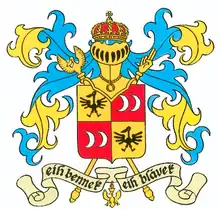Marols
Marols or Marollien (also known as brusseleer,[1] brusselair or brusseleir) is a near-extinct dialect spoken in Brussels. Essentially it is a heavily Frenchified Brabant-Dutch dialect additionally incorporating a sprinkle of Spanish dating back to the rule of the Low Countries by the Habsburgs (1519-1713). Its name refers to a district of Brussels called Marollen (Marolles), a neighborhood in the south-central municipality of Brussels, not far from the Palace of Justice. The district takes its name from the former abbey of the nuns Maria Colentes[2] (Marikollen). It was a working-class neighborhood, though now it has become a fashionable part of the city. Marols is described as "totally indecipherable to the foreigner (which covers everyone not born in the Marolles) which is probably a good thing as it is richly abusive."[1]
| Marols | |
|---|---|
| Brusseleir | |
| Native to | Belgium, specifically Brussels |
| Language codes | |
| ISO 639-3 | – |
The Royal Theatre Toone in Brussels puts on puppet plays in Marols.[1]
What is Marols?

There is a dispute and confusion about the meaning of Marols, which many consider to be a neighborhood jargon distinct from a larger Brussels Dutch dialect, while others use the term "Marols" as an overarching substitute term for that citywide dialect.[3] According to Jeanine Treffers-Daller, “the dialect has a tremendous prestige and a lot of myths are doing the rounds.”[3]
If you ask ten Brusselers what “Marollien” is, you get ten different answers. For some people it is French contaminated by Flemish and spoken in the neighborhood of the rue Haute and the rue Blaes, whereas for others it is Frenchified Flemish. Still others say that it is a vernacular variety of French, spoken in the whole city, etc., etc. Marollien, however, is exceptional if not unique, because it is a double language. In fact it is not between the germanic and romance languages, it is both.
— Jacques Pohl, 1953, [4]
Origins
A local version of the Brabantian dialect was originally spoken in Brussels. When the Kingdom of Belgium was established in 1830 after the Belgian Revolution, French was established as the only official language of the kingdom. French was therefore primarily used amongst nobility (however some in the historic towns of Flanders were bilingual and stayed attached to the old Flemish national literature), the middle class and a significant portion of the population whose secondary education had only been delivered in French.
French then gradually spread through the working classes, especially after the establishment of compulsory education in Belgium from 1914 for children aged between six and fourteen years. Primary school education was given in Dutch in the Flemish regions and in French in the Walloon regions. Secondary education was only given in French throughout Belgium. Drained by the personal needs of the administration, many new working class arrivals from the south of Belgium, again increased the presence of French in Brussels. Today, French is the primary language used in Brussels.
Informal language was from then on a mixture of Romance and Germanic influences, which adapted into becoming Marols.
Examples
An example of Marols is:
Na mooie ni paaze da'k ee da poèzeke em zitte deklameire / Allien mo vè aile t'amuzeire / Neineie... ik em aile wille demonstreire / Dat as er zain dee uile me konviksen e stuk in uilen uur drinke. / Dat da ni seulement en allien es vè te drinke.
— In Standard Dutch: Nu moet je niet denken dat ik hier dat gedichtje heb zitten voordragen / Alleen maar om jullie te vermaken / Neenee… ik heb jullie willen tonen / Dat er [mensen] zijn die met overtuiging een stuk in hun kraag drinken. / Dat dat niet louter en alleen is om te drinken.
Marols and The Adventures of Tintin
For the popular comic series The Adventures of Tintin, the Belgian author Hergé modeled his fictional languages Syldavian[5] and Bordurian on Marols, and modeled many other personal and place-names in his works on the dialect (e.g. the city of Khemkhâh in the fictional Middle Eastern country of Khemed comes from the Marols phrase for "I'm cold"). Bordurian, for example, has as one of its words the Marols-based "mänhir", meaning "mister" (cf. Dutch "mijnheer"). In the original French, the fictional Arumbaya language of San Theodoros is another incarnation of Marols.
References
- Mary Anne Evans, Frommer's Brussels and Bruges Day by Day. First Edition (Hoboken: John Wiley & Sons, 2008), 71.
- http://latindictionary.wikidot.com/search:site/q/colere worshipping Mary
- Jeanine Treffers-Daller, Mixing Two Languages: French-Dutch Contact in a Comparative Perspective (Walter de Gruyter, 1994), 25.
- Quoted Jeanine Treffers-Daller, Mixing Two Languages: French-Dutch Contact in a Comparative Perspective (Walter de Gruyter, 1994), 25.
- Hergé's Syldavian
